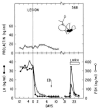Kisspeptin and the regulation of the hypothalamic-pituitary-gonadal axis in the rhesus monkey (Macaca mulatta)
- PMID: 18662732
- PMCID: PMC2661764
- DOI: 10.1016/j.peptides.2008.06.029
Kisspeptin and the regulation of the hypothalamic-pituitary-gonadal axis in the rhesus monkey (Macaca mulatta)
Abstract
The present article reviews recent studies of monkeys and, in some cases, humans that have been conducted to examine the role of kisspeptin-GPR54 signaling in the regulation of the hypothalamic-pituitary-gonadal axis in higher primates. This area of peptide biology was initiated in 2003 by the discovery that loss of function mutations of GPR54 in man were associated with hypogonadotropic hypogonadism and absent or delayed puberty. Puberty in the monkey, an experimental model commonly used to study this fundamental developmental stage, is first described. This is followed by a review of the role of kisspeptin in the regulation of the postnatal ontogeny of GnRH pulsatility. The roles of kisspeptin in GnRH pulse generation and in the feedback loops governing gonadotropin secretion in primates are then discussed. A brief section on kisspeptin-GPR54 signaling at the pituitary and gonadal levels is also included. The review concludes with a discussion of the phenomenon of GPR54 downregulation by continuous exposure to kisspeptin and its therapeutic implications.
Figures








References
-
- Dhillo WS, Chaudhri OB, Patterson M, Thompson EL, Murphy KG, Badman MK, et al. Kisspeptin-54 stimulates the hypothalamic-pituitary gonadal axis in human males. J Clin Endocrinol Metab. 2005;90:6609–15. - PubMed
-
- El Majdoubi M, Sahu A, Plant TM. Changes in hypothalamic gene expression associated with the arrest of pulsatile gonadotropin-releasing hormone release during infancy in the agonadal male rhesus monkey (Macaca mulatta) Endocrinology. 2000;141:3273–77. - PubMed
-
- Fraser MO, Plant TM. Further studies on the role of the gonads in determining the ontogeny of gonadotropin secretion in the guinea pig (Cavia porcelus) Endocrinology. 1989;125:906–11. - PubMed
-
- Freeman MC. Neuroendocrine control of the ovarian cycle of the rat. In: Challis JRG, de Kretser DM, Neill JD, Pfaff DW, Plant TM, Richards JS, Wassarman PM, editors. Knobil and Neill's Physiology of Reproduction. Third. Chapter 43. Vol. 2. San Diego: Elsevier; 2006. pp. 2327–88.
Publication types
MeSH terms
Substances
Grants and funding
LinkOut - more resources
Full Text Sources

